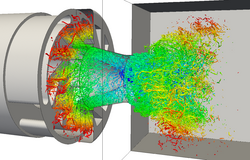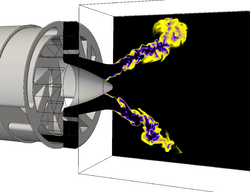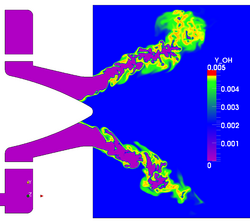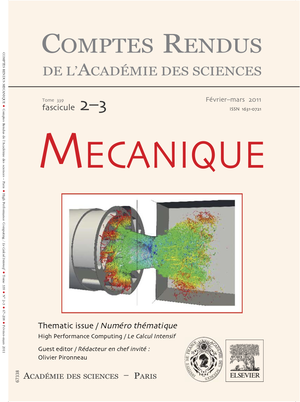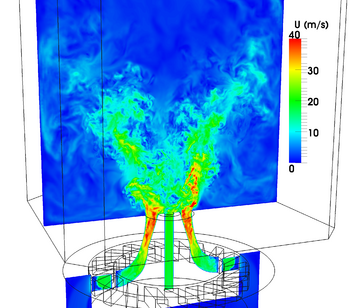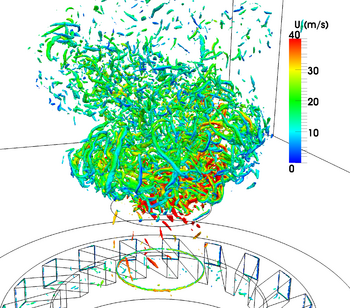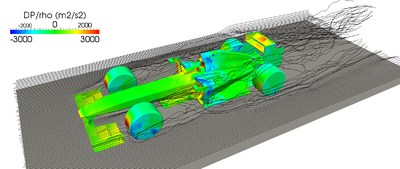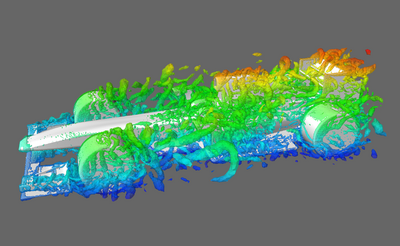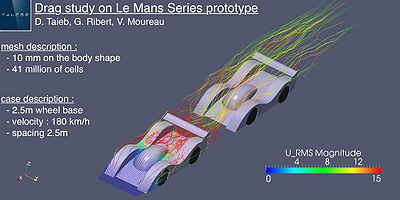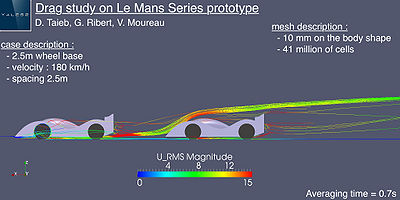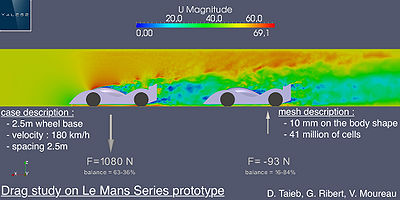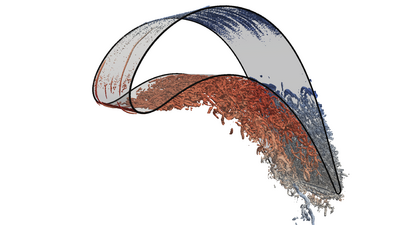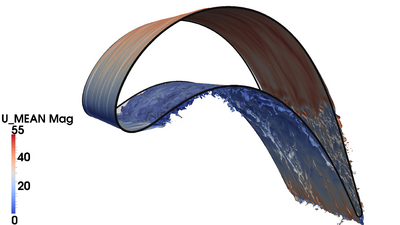YALES2 Gallery
Contents
Combustion
PRECCINSTA Burner (Vincent Moureau)
Direct Numerical Simulation of an aeronautical burner [1]. The mesh features 2.6 billion tetrahedrons and a resolution of 100 microns.
|
|
|||
KIAI burner (Vincent Moureau)
Large-Eddy Simulations of a swirl burner designed and operated at CORIA (J.P. Frenillot, G. Cabot, B. Renou, M. Boukhalfa).
Stratified combustion (Catherine Gruselle, Vincent Moureau and Ghislain Lartigue)
Large-Eddy Simulation and Direct Numerical Simulation of flame kernel development in a stratified propane/air mixture. The turbulent simulation (left movie) reproduces the experimental measurements of Balusamy S., Lecordier B. and Cessou A. from CORIA.
Aerodynamics
Formula One (David Taieb, Guillaume Ribert & Vincent Moureau)
Computation of a Formula 1 meeting with the 2010 regulations.
The design is based on the 2008 car which was simulated with the Fluent software with less than one million cells. The new car has the main features observed during the early part of F1 season, like the coca bottle shaped sidepods, the double-deck diffuser, the outer mirror disposition (forbidden by the FIA in the second part of the season), the three elements front wing.
The body of the car is discretized with 6.5mm element leading to 36 M cells in the computational domain.
Interaction between two Le Mans Series prototypes (David Taieb, Guillaume Ribert & Vincent Moureau)
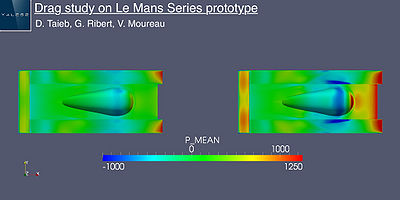
| |
Heat transfers
T7.2 Blade (Nicolas Maheu)
Large-Eddy Simulation of heat exchanges on a turbine blade.
Two-phase flows
Triple disk injector (Vincent Moureau)
Computation of a Triple Disk injector (Grout et al 2007). The densities and viscosities are those of water and air at atmospheric pressure and temperature. The video on the left was performed with 203 million tets and the one on the right with 1.6 billion tets with a resolution of 2.5 microns.
|
|
Pouring flow (Vincent Moureau and Olivier Desjardins)
Sample computation of a 2D two-phase flow with realistic properties for air and water to highlight the robustness of the method developed by Desjardins and Moureau at the 2010 CTR Summer Program.
|
|
Splashing (Vincent Moureau)
2D computation with YALES2 of a Lagrangian spray splashing on a wall and forming a film modeled with a level set and the Ghost Fluid Method. The grey particles and the grey film have the properties of water and the color represents the velocity magnitude in the gas. The Lagrangian particle are one-way coupled to the gas through drag for sake of simplicity.
|
|
Lagrangian simulation of the MERCATO burner (Lola Guedot)
Bio-mechanics from I3M lab in Montpellier
Simulation of a cardiac cycle (Christophe Chnafa, Simon Mendez, Franck Nicoud)
|
|
3D computation of a cardiac cycle with the Arbitrary-Lagrangian Eulerian solver of YALES2. This solver and the calculations were done in the I3M lab of the University of Montpellier by C. Chnafa, S. Mendez and F. Nicoud. The color in the movie represents the vorticity.
The grid on which the fluid problem is computed is extracted from 4D (3D + time) medical images from a patient. Ten 3D images are taken from different times during the heart cycle. A grid is extracted from one medical image using a segmentation protocol. Then, grid deformations are computed from the combination of an image registration algorithm and of interpolations process. Hence, boundary movements are extracted from medical images and applied as boundary conditions for the fluid problem, resulting in a patient-specific computation. The spatial resolution is imposed to be close to 0.8 mm in all three spatial directions along the cycle, which yields grids of approximately three-million tetrahedral elements. Valves are modelled by immersed boundaries, and the heart is handled by a conformal mesh.
Advanced numerics
Immersed boundaries on unstructured grids (Vincent Moureau)
On the left, 2D computation with YALES2 of the flow around two moving cylinders with an immersed boundary technique implemented for unstructured grids. The color represents the velocity magnitude. On the right, simulation of a stirred-tank reactor with YALES2. The mesh consists of 31 million tetrahedra. Simulation performed by V. Moureau from CORIA and N. Perret from Rhodia-Solvay.
|
|
Mesh deformation (Vincent Moureau)
Demonstration of 2D mesh deformation with YALES2. Only the velocity of boundaries is prescribed and the movement of the nodes is found by inverting an elliptic system. Edge swapping is also activated in this example.
|
|
